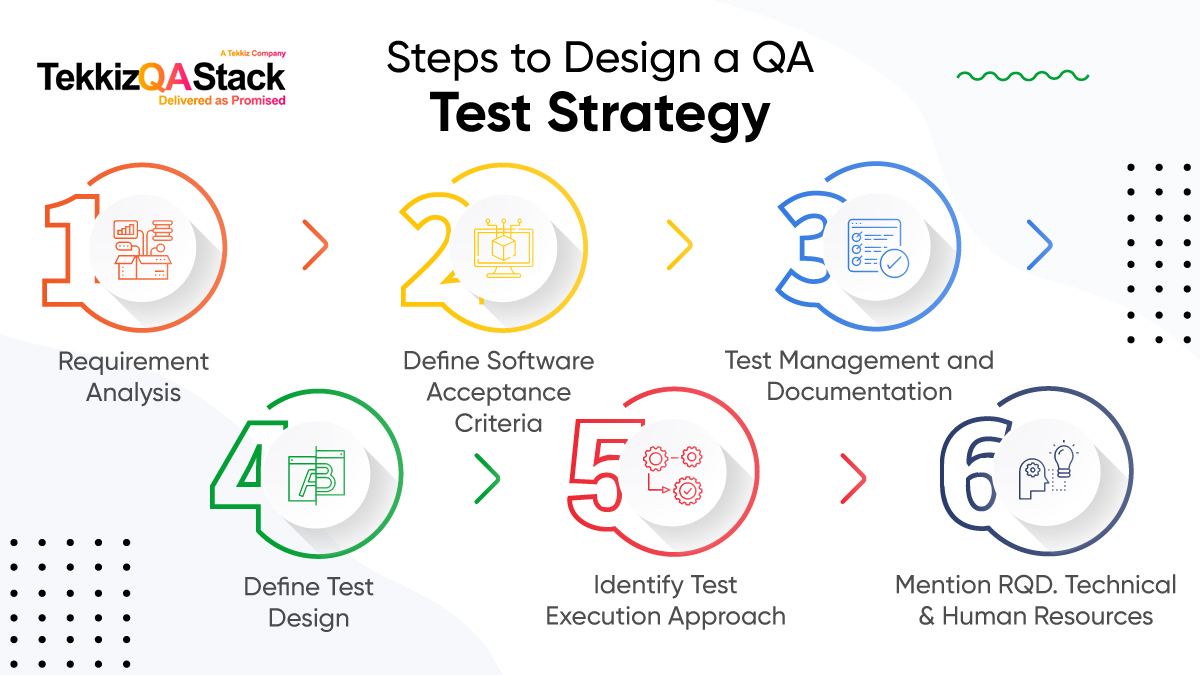At TekkizQA Stack, we utilize a Quality Assurance technique as an outline that manages all product testing exercises inside a task, and I accept that an organized Quality Assurance methodology is one of the key elements impacting venture achievement. A successfully designed QA strategy helped us achieve a 25% reduction in testing time, which let our customer release quality software and meet a strict deadline.
6 Steps of TekkizQA Stack’s Approach to Quality Assurance Strategy Design
The key thought behind our methodology is fitting a Quality Assurance system to the eccentricities of a particular application, project, and association. To understand this methodology, TekkizQA Stack’s QA group performs the following activities:
1. Requirement Analysis
There are various elements forming a QA technique, and before getting down to arranging, all things considered, we commit exertion to dissect these elements:
Domain Specifics
Applications utilized in various areas require various profundities of and ways to deal with testing. Breaking down the particulars of the area, we at TekkizQA Stack essentially consider the eccentricities of the client stream in the space, the severity of space’s prerequisites to programming quality, and the need for an application to consent to space explicit guidelines.
For example, testing hospital applications, which ordinarily require a total test inclusion, have a complex client stream and need to agree to HIPAA, we guarantee that all application necessities are secured with experiments, act inside and out testing of high-risk areas, and check an application for consistency with relevant HIPAA shields.
Organizational and Project Specifics
Planning a QA methodology, TekkizQA Stack’s Quality Assurance Consultants ensure that a QA group doesn’t face roadblocks when following it. For that, we analyze the processes received inside a client’s association (e.g., project initiation and the executives) and task (e.g., information move and risk management), and make a point to consistently mesh a QA procedure into these cycles.
Delivery Plan Specifics
As my associate, Nancy, Software Testing Team lead at TekkizQA Stack, described in her guide to the QA process, testing in Agile has certain points of interest when contrasted with testing in straight procedures, and we reflect these particulars in a Quality Assurance system. As opposed to a conviction that Agile projects needn’t bother with a testing procedure as they esteem working programming over documentation, in our Agile tasks, we don’t dispose of a testing methodology, however, adjust it to the Agile points of interest, for example, prioritizing software’s functional modules based on risk and combining partial and full regression testing.
Software Requirements
We analyze functional and non-functional prerequisites to programming and other recently made and already available design documentation to define the scope and levels of testing, perform test prioritization, and concoct an ideal test group structure.
2. Define Software Acceptance Criteria
Clearly defined acknowledgment standards help us understand exactly what kind of behavior a particular feature must exhibit and permit us to guarantee that we have a common understanding of the prerequisites to programming with our clients. Explaining the acknowledgment measures, I ensure that every model is testable and has clear pass and failure scenarios.
3. Test Management and Documentation
At the beginning of cooperation, a client and TekkizQA Stack’s test group agree on the conditions to be met for us to begin testing exercises. For example, we set up a deadline for the customer’s development team to actualize certain functionality. For the straightforwardness and reliability of the delivered services, we also agree to the test expectations to be given for the client all through the project.
4. Define Test Design
We single out test groups and define the way to deal with test prioritization and test records maintenance.
Test Groups
To encourage the creation and support of test plan documentation and cultivate test prioritization, we divide software functionality into areas dependent on their practical similitude. For example, testing internet business stages for our clients, we single out such practical regions as sign-in/sign up, site search, product catalog management, product catalog management, and others.
Test Priorities
Defects in some product modules can present risks to its users or hamper an application release. While in different modules, deserts don’t impact the nature of programming a lot, and experiments covering such modules can be viewed as restorative. In TekkizQA Stack’s software testing projects, we organize the execution of experiments covering high-risk modules and state it in a Quality Assurance strategy.
Test Record Maintenance
Executing experiments, TekkizQA Stack’s test groups monitor the execution brings about the type of test records. We ensure that the test records contain the data about who and when executed a specific experiment, how long the execution took, and what the aftereffect of execution was. We characterize the data to be remembered for the test records and the index where the records will be put away in a test strategy.
5. Identify Test Execution Approach
TekkizQA Stack’s Quality Assurance consultants define the test levels at which testing will be performed, an approach to regression testing, and test status collection and reporting.
Test Levels
To ensure ideal test inclusion, we recognize the share of testing to be performed at the unit, joining, and framework levels. To keep defects from entering later project stages, we favor taking a bigger portion of testing exercises nearer to the start of the conveyance pipeline, encouraging development teams to perform unit testing, and taking over at the integration and system levels.
Approach to Regression Testing
At TekkizQA Stack, we treat regression testing as a significant aspect of the testing degree as it guarantees that defect fixes neither broke nor changed the current usefulness. Truly, however, a test group is regularly in a rush and needs to look for approaches to optimize regression testing. In TekkizQA Stack’s undertakings, for example, we may decide on test mechanization to stimulate the testing cycle or decide to combine partial and full regression testing dependent on risk.
Test Status Collection and Reporting
In TekkizQA Stack’s tasks, we gather the contribution from individual testers about the status of programming testing exercises in an extensive and give it to the client as per an agreed schedule. We state how frequently the test outcomes reports will be given to the client in a test technique.
6. Mention RQD Technical and Human Resources
We identify the environment(s) required for testing, ensuring that the environment or their mix is practical to keep up and accommodates exact test outcomes. I think of it as ideal to utilize an advancement situation for integration testing and verification of fixed bugs, a staging environment – for framework testing, and a creation situation – for acknowledgment testing.
At this point, I also identify the roles and responsibilities of the QA team members to be involved in a project.
An Approach put into Practice
Based on my experience in one of TekkizQA Stack’s tasks, I’ll show how the components of the portrayed methodology work by and by. The client, a supplier of security review and consistency administrations, appointed us to create and execute a testing procedure for test measure improvement. The client needed to follow a tight task timetable and expected to upgrade joint effort among their few Quality Assurance groups.
To optimize a customer’s Quality Assurance strategy, I suggested:
Parting the testing extension into modules and appointing a committed test group to each. This helped the client dodge correspondence failures among their few QA groups.
- Parting the testing extension into modules and appointing a committed test group to each. This helped the client dodge correspondence failures among their few QA groups.
- Performing programming risk investigation and organizing testing of high-risk programming modules – they must be tried before in the improvement cycle by test engineers with deeper domain expertise.
- Arranging a dedicated test environment and setting up a test information library, which improved testing reliability.
- Automating regression testing depending on the manual experiments that reliably identified bugs, which altogether expanded testing speed.
Accordingly, our customer reduced the testing time by 25%, improved the correspondence among a few QA groups, and delivered a great application regarding the tight deadline.
A Neat QA Strategy for Outstanding Quality Outcomes
I am convinced that a Quality Assurance methodology is important to construct an organized Quality Assurance process, and I encourage you to design up and coming QA exercises ahead of time. In the event that you need to ensure that your QA procedure is practical or need assistance in planning one, my partners at TekkizQA Stack and I will be happy to enable it, Just let me know.



